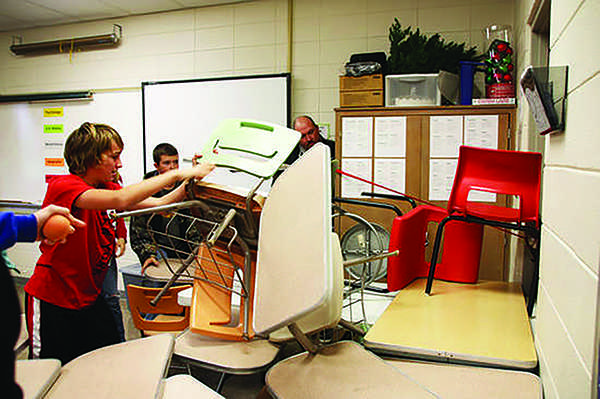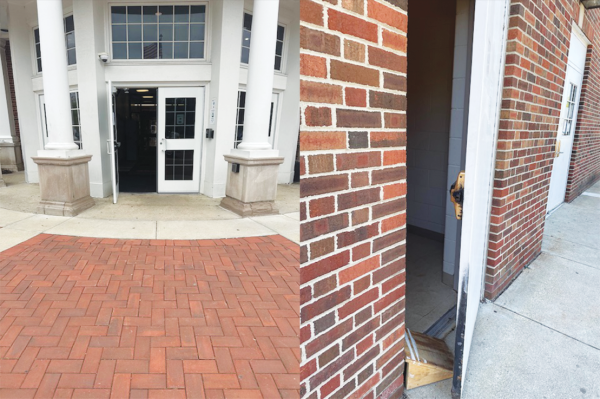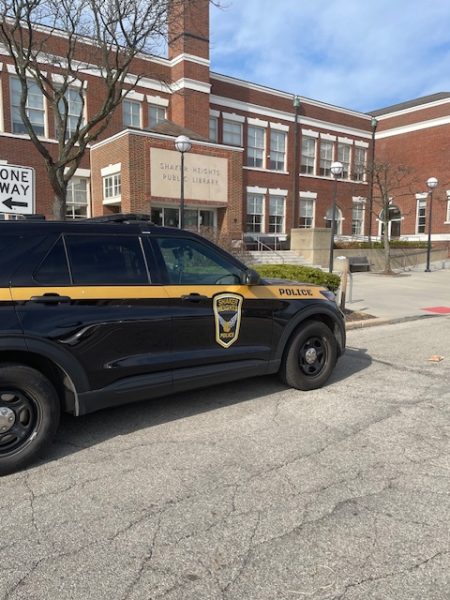District Communication Blunders Spark Dismay, Chaos
Administration’s failure to relay detailed information on shooting threat triggers widespread community concern and confusion

Students at Richland Junior High in Essex, Missouri barricade a classroom door during ALICE training session. Shaker previously considered this training to teach students how to react to an intruder.
As terrifying as last month’s threat was, it wasn’t as rare as one might think. Kenneth Trump, President of National School Safety and Security Services, stated that there were more than 800 threats made against schools in the United States from January to May in 2014, one-third of which were electronic. This exemplifies both the strong positive and negative aspects of social media.
On one hand, social media allows people to connect with one another. However, it also provides a frightening opportunity to obscure identity and spread false information.
“Because [social media] is so — in essence — decentralized, and it’s a ground roots form of communication, that means there’s less control,” high school Individuals and Societies teacher Yvonne Horstman said.
The day of the threat, students went straight to their social media accounts, spreading information, regardless of factual accuracy.
“Who’s communicating the accurate information?” Horstman asked.
“I can tolerate some uncertainty about the best substantive response to something like this, but it’s harder for me to tolerate the gap in how the schools and the community, including the police, advice is communicated,” said Shaker parent Anne Flamm.
Principal James Reed first came on the PA system with a vague announcement for teachers to check their emails during first period. Uninformed parents and students were forced to read between the lines of Reed’s cryptic directive.
“I was scared,” said sophomore Paige Campbell, who was at Raiderettes practice when the first PA announcement was made. Her instructor, Sally Davros, had no access to a computer during their practice in the multipurpose room. Many Raiderettes learned of the threat in the locker room through the student body’s’ word of mouth.
Rather than following a lockdown procedure, students were told that they could leave the building so long as they were excused by a parent.
“Everybody else was leaving, I didn’t know what was going on and I saw a K-9 unit. I think they should have evacuated the building,” freshman Tavon Amie said.
Due to this lack of communication, students disregarded the district’s plan and instead formed their own. When asked to comment about the administration’s handling of the threat, many teachers refused.
Empathy and assurance of safety needed to be addressed with real solutions and tactics.
“There was too much ambiguity in the plan for when students returned,” said Molly Markey, Shaker mother of two.
“I was dismayed that the message given to students, and then to parents, was sort of ‘Do what you think is best,” Flamm said.
Between fleeing students and frantic parents, the school became a chaotic free for all — a sharp contrast to the quiet calm of lockdown procedure.
“When I entered the school, there were students and adults [parents] everywhere, kids just walking out of all different doors. I even saw kids letting other students back into side doors,” Markey said.
A second — more desperate — PA announcement aired during second period to help quell students’ worries and encourage them to proceed with their regularly scheduled day. This was to no avail, seeing as more than 600 students had already left.
If anything, the administration’s response to Wednesday’s threat piled more doubt and distrust into students’ minds. Providing more information, or even setting a solid plan for us to follow, could have avoided a major exodus of students.
“The more that the communication can be transparent, the calmer the situation ends up being,” Horstman said.
Unfortunately, communication from school to community is significantly flawed.
At a high school assembly focusing on the safety of our school, Reed revealed that a startling number of students’ family contact phone numbers proved to be incorrect at the time of the threat — 60 percent, to be exact. That means parents did receive the robocalls that the district relies on to share information to students’ families.
“I never got a phone call. You would imagine that if something awful was happening at any school, that we would be called,” said Kelly Kornblut, Shaker parent and a Special Education Aid at Joseph and Florence Mandel Jewish Day School.
“My first reaction was just simply shock, and in that moment, I believed that my life was at risk,” freshman class president Kevin LaMonica said. “I wanted to leave because I felt safe anywhere but there.”
“Schools should only go into lockdown when something happens during the school day, and this was before the school day, so I think it just makes more sense for us to not go to school knowing that there’s a threat,” senior Jamie Semel said.
“One of the problems was the storm of parents coming in and crowding the school, but the finger to point here is at the administration. Their lack of communication was the cause of the mob of parents,” added sophomore Madi Hart.
There have been more than 100 school shootings since the horror at Sandy Hook Elementary School in 2013. When compared to the thousands of peaceful American schools, this number is relatively small, but the fact that gun violence has affected one school at all is disturbing enough.
“In today’s world it’s becoming an epidemic that kids are threatening schools on a weekly basis or monthly basis.
“Who knows if it’s a false alarm or if it’s a true person that is going to follow through on a threat?” Kornblut said.
It’s terrifying to consider Shaker Heights as a vulnerable school, but it’s necessary to prepare for the worst and consider: What if?
Lockdown drills aren’t just a break from learning the ABC’s anymore. They’re training for something that, as terrifying as it sounds, could happen.
Prior to the threat, there was a routine lockdown drill at the school on Thursday, Oct. 1. Given recent events nationally, the atmosphere was more tense than usual.
Shaker currently follows a hide-and-seek lockdown procedure. Students squeeze into corners while teachers try to lock their doors as quickly as possible. The notion is that a locked door and dark classroom would act as a brick wall against intruders, but in reality, the system is faulty.
Problems arose after Shaker’s latest lockdown drill, where it was revealed that several high school classroom doors don’t properly lock. As police officers routinely tugged on door handles to check their security, petrified students watched the doors fly open.
Unbeknownst to the school, as students crouched behind desks, hiding from an imaginary intruder, Oregon Community College experienced a horrible reality as a gunman terrorized their school.
Disturbing as it is, this irony displays how important a solid crisis plan is for schools nowadays.
Past school shootings similar to Oregon prompted a reevaluation of instituted lockdown procedures. In recent years, Shaker considered adopting ALICE — Alert, Lockdown, Inform, Counter, Evacuate — the alternative lockdown training program. The ALICE Training Institute claims to go a step further than the conventional lockdown drill that Shaker and many other high schools currently exercise. Instead of students hiding from the intruder like sitting ducks, ALICE training calls for barricades and, as a last resort, active defense.
“Why wait to see if an intruder will come to you? If you’re able to escape … you do so,” Kornblut said. “Do you wait for a fire to come to you? No, you escape. Intruders should be treated the same way.”
Kornblut added, “I absolutely think ALICE is a program that not only the high school should adopt, but a program that I think every school district in the state of Ohio should adopt. ALICE has shown a better result in ‘happy endings.’”
Is it possible Shaker’s hide-and-seek lockdown policy could take away our own “happy ending?”
“Just sitting in a classroom against the wall isn’t going to save our lives,” Campbell said.
Gun violence is certainly not limited to schools. The Second Amendment argument can’t cover the facts.
Data from the Centers for Disease Control and Prevention states that there are approximately 81,300 nonfatal injuries and 31,672 deaths every year involving guns.
That works out to about 308 shootings and 86 deaths every day.
“It’s not like they [administration] needed to tell us everything” Hart said, “but because we weren’t given even a baseline of information the whole situation induced anxiety and panic.”




